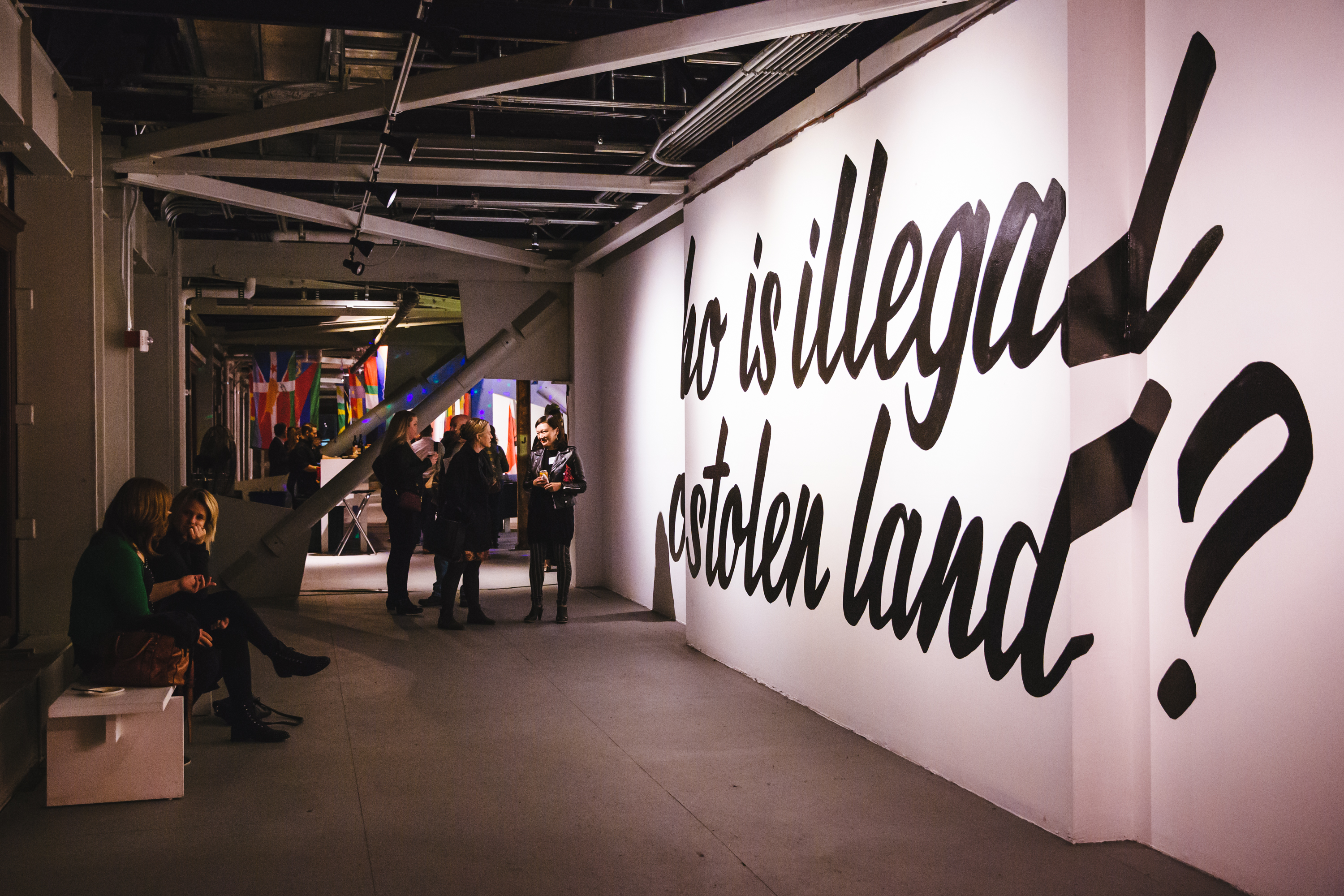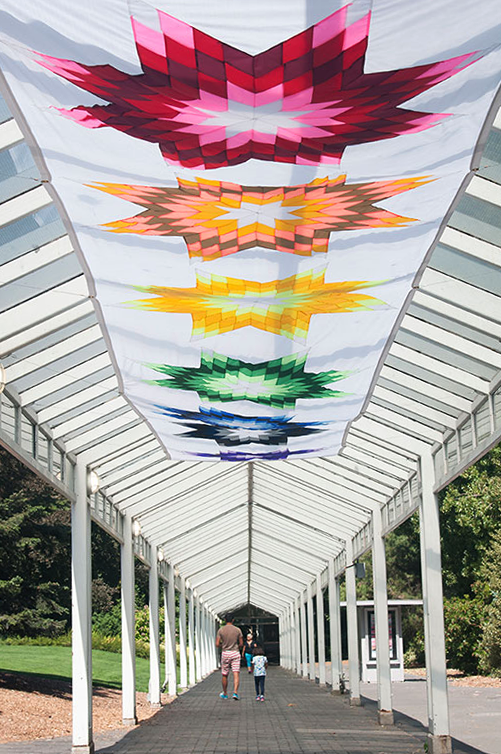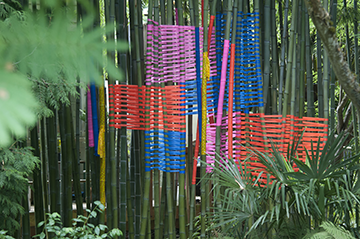
Art empowers people to better to understand their communities and their lives. It increases the liveliness and vitality of a city, and even improves property value. In the more than 40 years since the signing of the public art ordinance, the Office of Arts & Culture has invested in creating vibrant public areas through public art. Seattle was one of the first cities in the United States to adopt a percent-for-art ordinance in 1973. Our public art program integrates artworks and the ideas of artists into a variety of public settings, advancing Seattle's reputation as a cultural center for innovation and creativity.
The program specifies that 1% of eligible city capital improvement project funds be set aside for the commission, purchase and installation of artworks in a variety of settings. By providing opportunities for individuals to encounter art in parks, libraries, community centers, on roadways, bridges and other public venues, we enrich residents' daily lives while giving voice to artists.
Three public art projects received national recognition from Americans for the Arts Public Art Network's 2017 Year in Review. Year in Review highlights the most successful, innovative, and exciting public art projects and programs in the United States. This year the public art team was recognized for Vessels, a permanent public art piece by Nicole Kistler, BorderLands, the first exhibition ARTS organized at King Street Station, and Poetry on Buses, a collaboration with 4Culture.

The City's public art collection includes more than 450 permanently sited and integrated works and nearly 3,000 portable works. Artworks are commissioned through a public process, with artists selected by panels comprised of professional visual artists along with community and city representatives evaluate the artist applicants. The city stewards and maintains its artworks through an ongoing program of coordinated conservation activities, which include inspections, major restorative work and routine maintenance.

August 3 – December 31, 2017
Temporary artwork in the Delridge Neighborhood Greenway and Connector Trail Commissioned with Seattle Department of Transportation 1% for Art funds
Art Interruptions, an annual temporary art program created by the Office of Arts & Culture in partnership with the Seattle Department of Transportation, offered ephemeral moments of surprise and reflection within the Delridge Neighborhood Greenway and Delridge Connector Trail. Seven temporary installations were on view in the greenway.
The artworks ranged from life-size vinyl portraits to a sculptural bat house. The seven selected artists include Jasmine Brown, Susan Brown, Ryan Burns, Maria Jost, Tia Matthies, Akira Ohiso, and Shawn Parks. Each artist designed a series of small-scale temporary artworks installed on city-owned street furniture and infrastructure, including signal boxes, utility poles, sidewalks, and street trees, as well as on a limited number of private properties where visible from the street.
Home, Change and Survival
January 28, 2017 – May 2018
Lincoln Reservoir Gate House at Cal Anderson Park
The historic Lincoln Reservoir Gate House at Cal Anderson Park hosted Home, Change and Survival, an installation of original temporary artworks created by 12 Washington Middle School students. The artworks grace the windows of the gate house and feature images that reflect on feelings of home, forces that create change, and survival. The gate house project was a collaboration between the Seattle Office of Arts & Culture, Seattle Parks and Recreation's Out of School Time program at Washington Middle School, Seattle Public Utilities and Seattle Department of Neighborhoods Historic Preservation Program. Students worked with teaching artists Nate Herth and Henry Luke over ten weeks to design and create 14 original paintings.
Seattle Center Sculpture Walk, 2017
August 3 – December 31, 2017
Supported by Seattle Center and the Office of Arts & Culture, sponsored by Alaska Airlines.
Seattle Center was home to eight temporary artworks that invited the viewer to discover Seattle's cultural "Heart of the City". The program aimed to cultivate an atmosphere where all people can feel a sense of belonging, and participate in community and something bigger than themselves. The 2017 Seattle Center Sculpture Walk featured the works of artists Hugo Moro, April Soetarman, Henry Jackson-Spieker, Randi Ganulin, Erin Genia, Kalina Chung, Tara Tamaribuchi, and Sofia Babaeva.
Seattle Center Poetry Garden Art Series
February 2017 – May 6, 2018
Seattle Center Poetry Garden
Commissioned by the Office of Arts & Culture, with funds from the Seattle Center.
The Office of Arts & Culture and Seattle Center commissioned five artists to develop temporary artworks for the 2017-18 Poetry Garden Art Series on the Seattle Center campus: Xavier Lopez, Jennifer Szabo, David Kelly-Hedrick, Barbara de Pirro, and Susan Palmer. To showcase various approaches of celebrating the value that cultural festivals bring to our community, the theme for this year's series of artworks was Seattle Center Festál Turns 20. This illuminating series of 24 ethnic cultural festivals seeks to connect people in ways that build understanding, dispel stereotypes and generate pride among the generations who participate in these shared experiences.
Put the Art in Parks
Commissioned by the Office of Arts & Culture, with funds from the Seattle Parks District
In partnership between the Office of Arts & Culture and Seattle Parks and Recreation, the Put the Arts in Parks program celebrated diversity, built community connections, and energized parks while connecting with underserved communities. The program featured temporary art installations in public parks throughout the city by artists Yeggy Michael, Kalina Chung, Devon Midori Hale and Cheryl Delostrinos, Michelle Lassaline, Carolina Silva, Ari Glass and Rome Esmaili, and Michiko Tanaka. Artworks were installed in four parks: Ballard Commons Park, Dr. Blanche Lavizzo Park, Delridge Playfield and Pritchard Island Beach.
Nicole Kistler
Beacon Food Forest
Commissioned with Seattle Public Utilities 1% for Art funds
A series of cast iron sculptures now dot the community garden that occupies Seattle Public Utilities property at Beacon Reservoir. Building on the inspiration of the reservoir as a container, these sculptures evoke puffball mushrooms holding spores, berries holding seeds, seed pods, and ceramic water jugs. Likewise, they hold stories from the community. Kistler interviewed volunteers and neighbors over several summer months to capture food stories and traditions on audio, and embedded them into the permanent works. The artist further fused social engagement with her permanent work through a series of seed ball workshops to bring attention to fruit and vegetable production in an urban setting. Kistler worked closely with the Food Forest's Steering Committee to integrate the organically shaped sculptures throughout this urban permaculture garden. Vessels went on to become 1 of 3 Seattle public art projects to receive national recognition from Americans for the Arts Year in Review program.
JewelBoats Jen DixonJewelBoats takes its inspiration from the reflective nature of Lake Union and its title from "Jewel of our City," as local residents call the Lake. Using boat forms to mirror the vibrant motion and fluidity of the lake, the three art installations – Glacial Canoes at the south end; Stone Dinghy, Crystal Kayak, and Diamond Speedboat at Galer Bridge; and Diamond Speedboat at the north end – reference the history of the lake's formation and usage, and emphasize the ongoing transformation of the water's reflective surface.
Drop of Life Oliver Hess Fire Station 22 – North Capitol Hill Commissioned with Facilities and Administrative Services Fire Facilities and Emergency Response Levy 1% for ArtDrop of Life is a sculpture designed to look like a symmetrical array of fire hoses connected to a stand pipe, formed in the shape of a drop of water falling through the air. At night, its lights rhythmically fade, brighten, and dim, reflecting the frequency at which this station's firefighters have been called into action, based on ten years of historical data.
ARTS maintains five galleries on the City's municipal campus. These galleries showcase the City's collection, display new and developing works and promote the work of emerging artists. Each gallery presented multiple exhibitions and residencies over the course of 2017.
City Hall and Anne Focke Gallery: featured Architecture of the Pacific Northwest – a playing card artwork project; Into the Pixel, which featured work by video game artists and storytellers; Coming of Age II, a celebration of fiber art by the Contemporary QuiltArt association; Hot Town – Summer in the City, an exhibition of 70 contemporary mixed media images by 37 Northwest collage artists; Indomitable: Contemporary Photography from Chiapas; and Cityscape, which displayed works from Geometica artist collective inspired by Seattle's rapidly changing skyline, in the style of geometric abstraction.
Ethnic Heritage GalleryArtworks from twelve local artists were featured at the Ethnic Heritage Gallery in an exhibition entitled Processing: Artists face administration change. The works reflected artist perspectives on recent changes to the federal administration and what these changes mean to them and their community. Participating artists included Jasmine Brown, Susan Emery, Nadya Glizina, Lauren Iida, Satpreet Kahlon, Hanoko O'Leary, Adrienne Lafaye, Xavier Lopez, Vikram Madan, Blanca Santander, Carol Williams, and Zorn Taylor. Following this exhibit, the Ethnic Heritage Gallery displayed research-based works by artist Danie Allinice exploring language-formed social-taxonomy.
Seattle Municipal Tower Gallery featured new additions to Seattle Public Utilities (SPU)'s portable works collection in a two-part installation entitled Your Body of Water. The exhibition aimed to visually explore our connections to water and the ways it is protected and cared for by SPU. Artworks from 31 local artists were featured, in mediums ranging from photography, to sculpture, to prints, to paintings. Pieces by the following artists were showcased in Part I: Carole Barrer, Susanna Bluhm, Patti Bowman, Michael Brophy, Linda Davidson, Joe Feddersen, Kathleen Fruge Brown, Christopher Gantt, Joy Hagen, Eirik Johnson, Amanda Knowles, Terrell Lozada, Steve MacFarlane, Linda McClamrock, Susan Point, Kate Sweeney, Lynda Swenson, Liz Tran, and Robert Williamson. Part II included works by Nola Ahola, Susanna Bluhm, Cable Griffith, Melissa Herzog, Tierney Hogan, Steve Davis, Marika Swan, Anna McKee, Naoko Morisawa, LessLIE Sam, Juliet Shen, Katy Stone, Kate Vrijmoet, and Inye Wokoma.
Seattle Presents Gallery presented Dialogues in Art: Exhibitions on Homelessness, a four-exhibition series in which artists and artist teams develop artistic projects on the topic of homelessness. Each two-month exhibition in the city's Seattle Presents Gallery explored what shelter and stability mean to diverse populations, and examined the systemic causes of homelessness. The series of four exhibitions featured installations by Xavier Lopez, Sloan Dawson and Sara Zwede, Tatiana Garmendia, and George Lee.
Borderlands at King Street StationARTS opened the third floor of King Street Station for Borderlands, the first public arts installation before the site is transformed into a permanent arts and culture hub. Borderlands featured 2D- and 3D site-specific installations and works from the City collection. Artist and educator Pedro Lasch's anchor project was accompanied by work from regional artists, all of which investigated themes of nationalism, belonging, and resistance. The Borderlands exhibition received national recognition from Americans for the Arts through the Public Art Network Year in Review program, joining 48 other public art projects from across the country.

The City of Seattle public art conservation team is responsible for the maintenance of the city's collection, one of the largest collections in the country. With over 450 permanently-sited artworks in both exterior and interior environments, the conservation team works diligently to perform both preventive and restorative treatments, using the best ethical and sustainable practices.
For 2017, staff worked with curators, consultants, and community members to determine which artworks would receive treatment. One treatment of significant depth included Duane Pasco's carved cedar poles entitled Bear and Tsonoqua (1975) in Occidental Park in Pioneer Square. These received a new coat of protective pigmented stains, consolidation of deteriorated wood, and reconstruction of areas of loss from by bird, insect, and human interaction.
Just around the corner on 2nd Ave South between Yesler Way and Washington Street, Anawog by Jan Evans (1978) was recoated in its bright, iconic "International Orange" paint.
Outside the city limits at the base of Rattlesnake Lake, Dan Corson's sight-and-sound installation Rain Drums (2001) in the Cedar River Watershed Visitor Center was recreated with new waterproof bodies, skins, and heads, and re-installed just in time for the rainy season.
Additional projects included the CO2-blasting of Doris Chase's Cor-Ten steel sculpture Changing Form (1971) in Queen Anne's Kerry Park, bronze restoration of George Tsutakawa's Heaven, Man, Earth (1978), and metal replacement to three of Brad Rude's artworks at the Woodland Park Zoo. ARTS also partnered with the Parks department to restore the George Tsutakawa's bronze Naramore Fountain (1966), located near downtown's Freeway Park, and his bronze Gates (1976) in the Washington Park Arboretum.
The treatment of public artwork, especially within an exterior setting, provides unique challenges for conservators. Whether maintaining the artist's conceptual integrity, evaluating structural soundness, or researching new methods and products, conservators are constantly balancing priorities to determine how to best ensure the longevity of the artworks.
Continue on to Equity